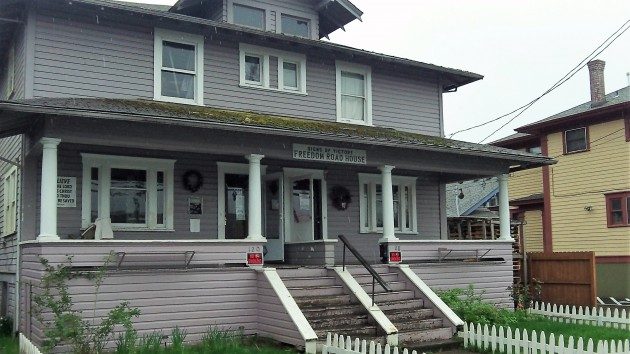
The Signs of Victory shelter on Seventh Avenue, which the mission wants to leave, last March.
Albany officials say the Signs of Victory Mission as been a big help in dealing with the community’s homeless. In return, the CARA urban renewal board Wednesday endorsed a $100,000 low-interest loan to help the mission finish a new homeless shelter across Jackson Street from the Linn County Jail and Sheriff’s Office.
The CARA loan is intended to help the mission pay for installing sprinklers and do other work needed to make 1100 Jackson Street ready to house otherwise homeless people overnight. Once the work is accomplished, the mission can shift its shelter there from the historic house at 118/120 Seventh Ave. S.E., where it has been for about 10 years or so.
Details of the loan are yet to be worked out. They include the interest rate (2 or 3 percent was mentioned) and exactly what work would be done and how soon. The mission plans to repay the loan from the proceeds of its Christmas tree sales.
City Manager Wes Hare, appearing before the CARA board, strongly endorsed the loan request by George R. Matland, who with his sister, Gale Armstrong-Cabrera, has run the mission since their mother’s death in 2006.
Last March, the CARA board tentatively approved a different kind of deal to help get the Jackson Street shelter established. It called for the city to buy the Seventh Avenue house and then sell it to be renovated. That transaction didn’t happen because of various complications.
Under the new deal, the mission says it will complete the Jackson Street work, move its shelter there and then try to sell the Seventh Avenue house, a duplex.
One reason why the police and other city officials like the mission, besides its other good works, is that it does not turn away people who have had too much to drink. This has proved helpful to the police when they need a place to take a homeless person to sleep it off. (hh)


This is certainly a worthy ‘feel good’ project for the privately run shelter.
But does the project justify putting Albany taxpayers into debt and then servicing that debt with tax revenue siphoned from multiple taxing districts?
CARA’s primary purpose is to create a return on investment (tax increment). CARA’s decision criteria for approving grants/loans requires a projection of the tax increment that will be generated. It’s part of being transparent to the public.
Another important consideration is that it must be shown that CARA is the ‘lender of last resort.’ In other words, no commercial bank would give the shelter a $100,000 loan.
Did CARA calculate the projected tax increment for this investment of public money?
Was evidence shown that the operators could not obtain $100,000 from a commercial source?
These same questions apply to the $2.4M CARA gave the Lake Oswego developer of the Edgewater project.
The justification for the project, I suspect, lies in enabling the shelter to move away from the 100 block of Seventh Avenue. This would allow for the possible renovation of the old house it now occupies, further eliminating blight on that block. Not all CARA projects require a calculation of return on investment. If they did, the big current street improvement project probably would not qualify. (hh)
Tax increment financing (TIF) creates funding for projects by borrowing against a future increase in property-tax revenues.
If CARA can’t demonstrate to taxpayers how much ‘future increase’ a project will generate, then CARA commits fraud by using TIF.
In these situations, TIF becomes nothing more than a political slush fund for the city council.
It also puts the property on 7th back on the tax rolls
“But does the project justify putting Albany taxpayers into debt and then servicing that debt with tax revenue siphoned from multiple taxing districts?”
Since Albany taxpayers will have zero change to their tax bill unless there is a property tax increase “tax increment” change from the Linn County Assessor, by whatever transpires in the URD, your comment is nonsensical to me. In addition, this will be a LOAN – and not an outright grant.
“CARA’s primary purpose is to create a return on investment (tax increment). CARA’s decision criteria for approving grants/loans requires a projection of the tax increment that will be generated. It’s part of being transparent to the public.”
By selling, and remodeling the existing blight at that location, the property “valuation” will improve — resulting in an improved tax increment. We have always been very-very transparent, sometimes to the point of being incredibly boring at times as Hasso can attest. All of that information is always available to the public: https://www.cityofalbany.net/city-council/bcc/cab Audio also available.
Good questions. I do notice that corvallis shelters always lower property values per their opponents.